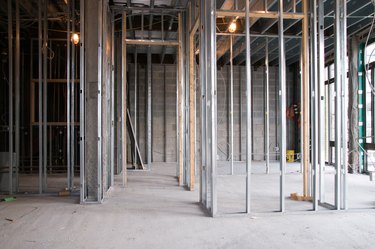
A floating foundation, or raft foundation as it's also called, is employed when a building is constructed on soil that contains a high mixture of clay, sand and water. Because of the way in which they're constructed, floating foundations spread the weight of the structure over the entire base of the building rather than at scattered support spots. Floating foundations are shallow, making them ideal for specific construction situations.
Types of Foundations
Video of the Day

Buildings are constructed on two types of foundations. Deep foundations – diaphragm walls, caissons or piles -- pass through unstable soil to get their support from deeper within the earth, on soils that are more solid. Shallow foundations -- floating, strip footings, pads or spread footings -- are used on strong soils, spreading the building's weight across the entire base of the structure. The most common shallow foundation is the strip footing that runs under all load-bearing walls.
Video of the Day
Low Load-bearing Capacity
Floating foundations are best in areas of low load-bearing capacity -- when constructing a building over loose soil -- or if the soil has varying degrees of compression compatibility. Construction of deep foundations will not be viable in new fill, sand and loose soil areas but, because floating foundations spread the support over a large area, there are no points of pressure taking a heavy load. To make the floating foundation stronger it might contain beams or ribs.
Nearby buildings
A floating foundation can be poured when other building foundations are close. To build deep foundations would interfere with the structure of other buildings.
Moisture
Floating foundations can be used on high moisture soils. The positioning of the foundation above the earth, rather than in it, helps create a moisture barrier between the ground and the structure.
Trenches
Floating foundations require far less digging because deep footer trenches are not needed. In addition, there is no need to disturb the earth beneath the building where there might be long-established tree roots or ground water.
Movement
If the earth is expected to move due to high underground moisture or high levels of vibration – as in the case of mining areas or heavily used highways -- floating foundations will not be compromised.